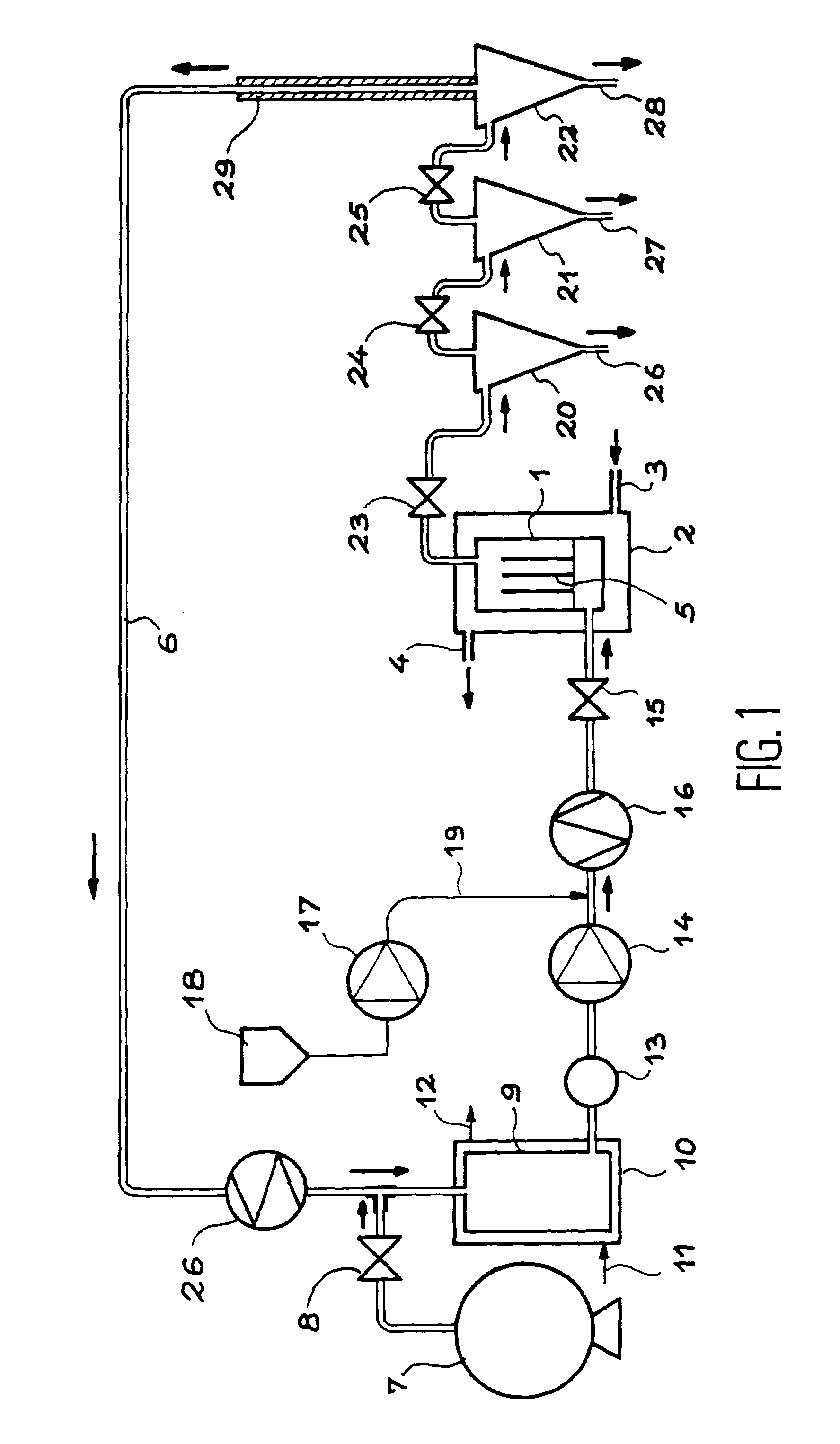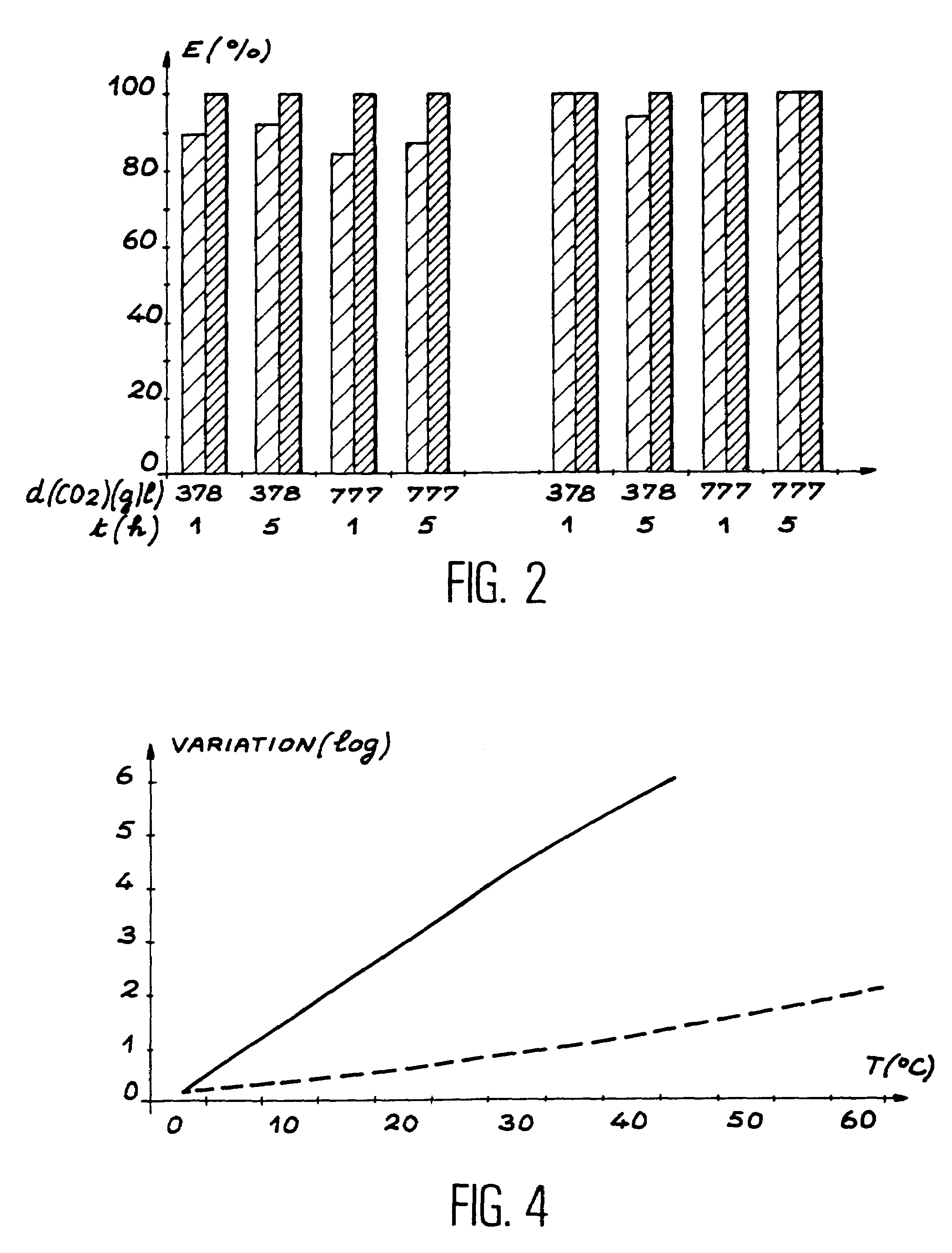Method for treating and extracting cork organic compounds, with a dense fluid under pressure
a technology of organic cork and dense fluid, applied in the direction of cleaning process, lighting and heating apparatus, cleaning of hollow objects, etc., can solve the problems of affecting the coherence of the natural pair, affecting the smell and/or taste, and a great deal of work throughout the process
- Summary
- Abstract
- Description
- Claims
- Application Information
AI Technical Summary
Benefits of technology
Problems solved by technology
Method used
Image
Examples
example 1
[0227]Parts (boards) made of cork representing a total quantity of about 400 g of cork were treated using the process according to the invention.
[0228]No prior boiling treatment was done on these parts.
[0229]The initial content of PCP and TCA after an analysis using the operating method defined above, was found to be 75 ppb for each contaminating product.
[0230]The operating conditions of the process according to the invention are generally as follows:[0231]co-solvent: distilled water at about 0.2° / oo;[0232]operating pressures: from 100 to 300 bars;[0233]temperature: about 50° C.;[0234]treatment time: from 1 to 5 hours;
[0235]At the end of this treatment, these cork parts are analysed to determine the residual content of PCP and TCA.
[0236]The mechanical strength of the bottle corks “tubed” from these boards is also measured by making measurements of the compression pressure “PC” and the return pressure “Pret” described above.
[0237]For the final evaluation, the measurements were also m...
example 2
[0245]The process according to the invention was used to treat cork parts (boards), with a total quantity of about 400 g of product.
[0246]Unlike example 1, these parts were previously subjected to a boiling treatment (immersion for 1 h 30 in water at almost 100° C.).
[0247]The initial content of PCP and TCA determined by analysis using the operating method described above, was found to be 50 ppb for each contaminating product.
[0248]The same measurements described in example 1 were made on the cork parts (boards).
[0249]These measurements were also made on bottle corks made from the control part not treated by the process according to the invention.
[0250]As in example 1, the results for the cleaning efficiency are shown in FIG. 2; whereas the results for the mechanical strength of bottle corks tubed from the parts (boards) are shown in FIG. 3 and are also given in table 1.
[0251]
TABLE 1PretPC (N / cm2)(N / cm2)Boiled boards (B)120 bars,Test P1Control B261.860° C., 1 h,BP1281.86.5 kg / h250 ba...
example 3
[0269]This example shows the anti-microbial efficiency of the process according to the invention when water, is added as a solvent to the dense fluid under pressure.
[0270]Parts of a substrate similar to the described material (cork) are thus treated by dense CO2 under pressure, to which 0.02% by weight of water has been added, at a pressure of 300 bars and under a temperature varying from 0 to 60° C.
[0271]The growth of micro-organisms is determined using the operating method described above.
[0272]Equivalent substrate (cork) parts are treated under the same conditions, but without any water being added to the dense fluid under pressure, and the growth of micro-organisms is determined once again.
[0273]The results obtained are shown in FIG. 4 that indicates the logarithmic variation of microbial growth obtained as a function of the temperature (in ° C.) applied during the treatment.
[0274]The curve shown in solid lines is the curve for treatment by CO2 to which water has been added, whi...
PUM
 Login to View More
Login to View More Abstract
Description
Claims
Application Information
 Login to View More
Login to View More - R&D
- Intellectual Property
- Life Sciences
- Materials
- Tech Scout
- Unparalleled Data Quality
- Higher Quality Content
- 60% Fewer Hallucinations
Browse by: Latest US Patents, China's latest patents, Technical Efficacy Thesaurus, Application Domain, Technology Topic, Popular Technical Reports.
© 2025 PatSnap. All rights reserved.Legal|Privacy policy|Modern Slavery Act Transparency Statement|Sitemap|About US| Contact US: help@patsnap.com



